Featured Comment:
“Ever since I watched your video and tried this recipe myself, kakuni has become our family’s favorite meal! We all absolutely love it. I’ve made it so many times now, and it’s all thanks to you. Please keep doing what you’re doing!”
– @UncleRa (from YouTube)
What is Buta no Kakuni?
Buta no Kakuni (豚の角煮) is a classic Japanese dish that showcases the rich flavors of pork belly, slow-cooked to perfection in a sweet and savory sauce.
The name itself is a direct reflection of its preparation: “buta” means pig, “kaku” signifies a square or cube shape, and “ni” denotes simmering. This dish is believed to have been inspired by the Chinese “Dongpo pork.”
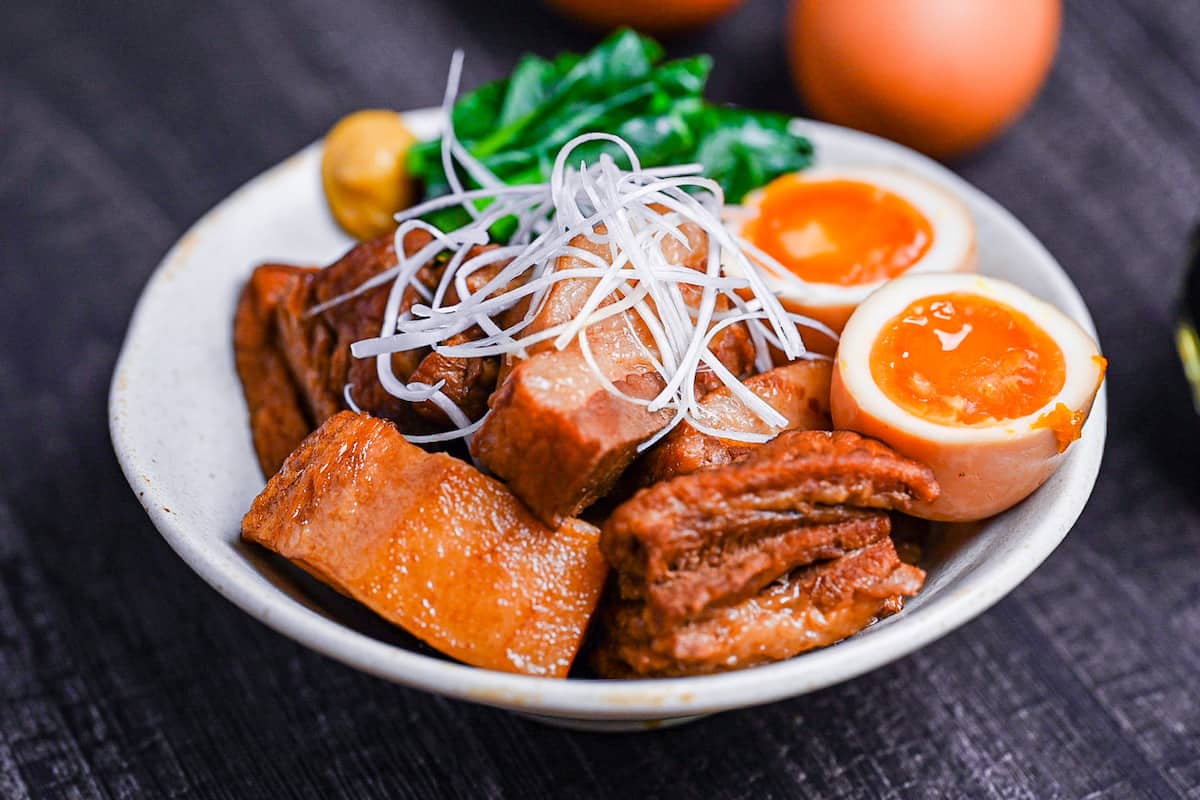
Interestingly, while many associate Buta no Kakuni with the southern regions of Japan, specifically Kyushu and Okinawa, variations of this dish can be found throughout the country.
Despite these regional variations, Buta no Kakuni is a beloved dish in households throughout Japan. It’s often accompanied by soft-boiled eggs, shiraganegi (thinly shredded white part of spring onions), and Japanese mustard. To add a pop of color and balance the richness, it’s often paired with blanched spinach or other greens.
And for a complete meal, serving it over rice is a must. Some even transform it into a donburi (rice bowl dish) or use the tender pork in steamed buns.
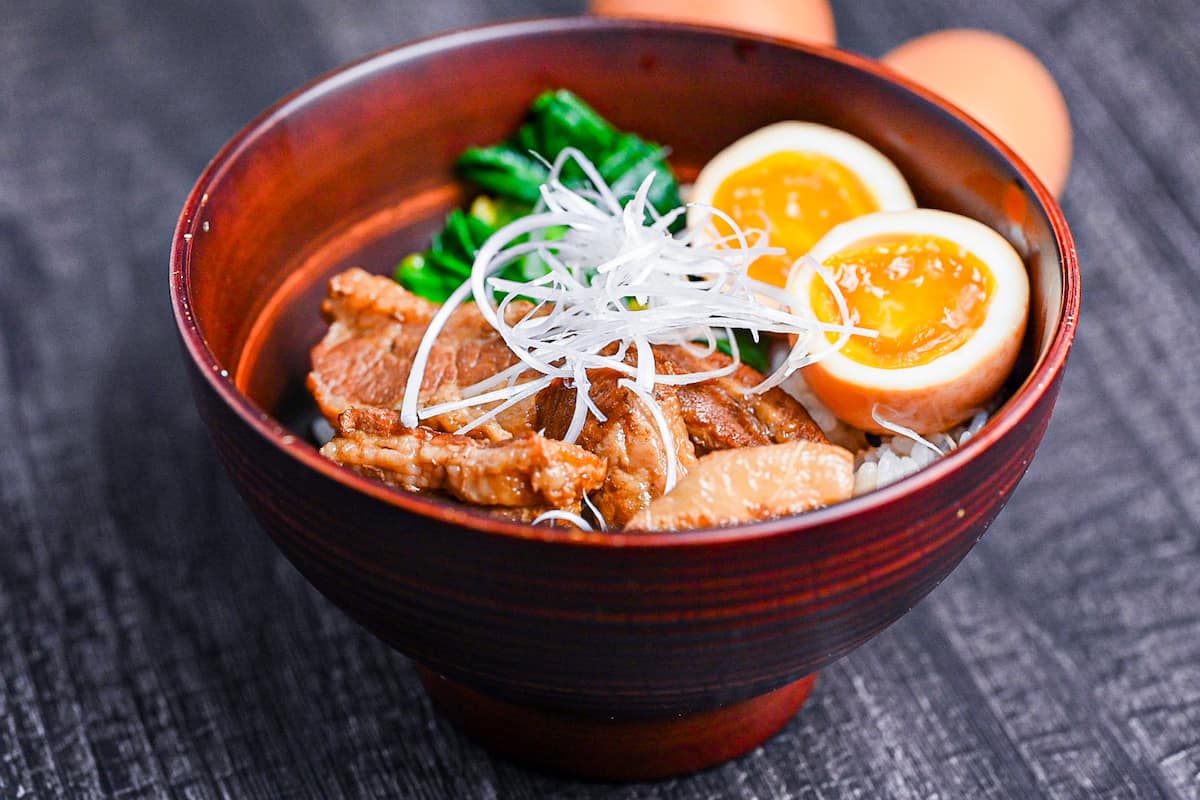

How I Developed This Recipe
Buta no kakuni is a dish that requires patience and attention to detail. It’s all about ensuring the pork belly achieves that melt-in-the-mouth tenderness that the dish is renowned for.
I also wanted to give this classic dish a bit of a contemporary twist. Instead of the usual sake, I used lager beer, which gave the dish a special flavor.
The cooking process is pretty lengthy, but it’s mostly hands-off. So, as the pork belly simmers away, absorbing all those delicious flavors, you just need to wait for the great result.
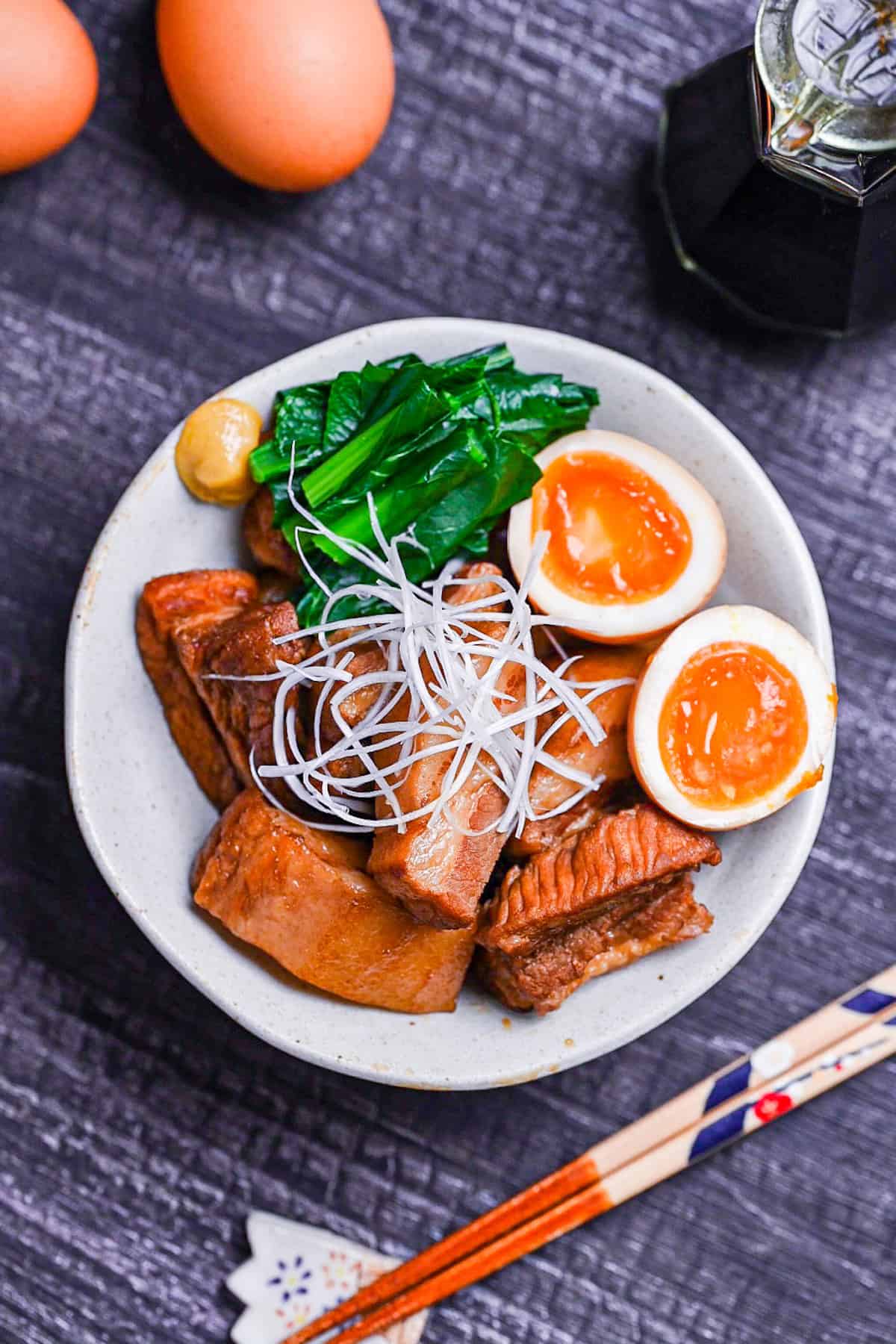
Ingredients & Substitution Ideas
- Pork Belly Block: Opt for a block-shaped cut for the best results.
- Odor-Reducing Ingredients: Leeks and ginger are used to neutralize the pork’s aroma. If leeks aren’t available, regular onions are a suitable alternative.
- Lager Beer: Any brand of lager beer is suitable for this recipe. For a more elegant touch, use an equal amount of white wine and for a more Japanese flavor, swap it for sake. Using alcohol contributes to the melt-in-mouth texture and I don’t recommend omitting it.
- Honey: A key ingredient in my buta no kakuni, honey imparts a unique sweetness and tenderizes the meat, giving it a glossy finish.
- Sugar: I typically use light brown cane sugar, but regular sugar will suffice.
- Soy Sauce: Refer to my complete soy sauce guide for a comprehensive guide on selecting soy sauce in Japanese cuisine.
- Soft-boiled Eggs: Although optional, I believe they’re an essential accompaniment to the dish.
- Japanese Leek: This is prepared as shiraganegi. For detailed preparation instructions, see my article on negi.
- Japanese Mustard (Karashi): Another optional ingredient, but I think the dish feels incomplete without it. Hot English mustard is a close match if you’re seeking a more accessible alternative.
Visual Walkthrough & Tips
Here are my step-by-step instructions for how to make Buta no Kakuni at home. For ingredient quantities and simplified instructions, scroll down for the Printable Recipe Card below.
If you prefer to watch the process in action, check out my YouTube video of this recipe for a complete visual walkthrough!
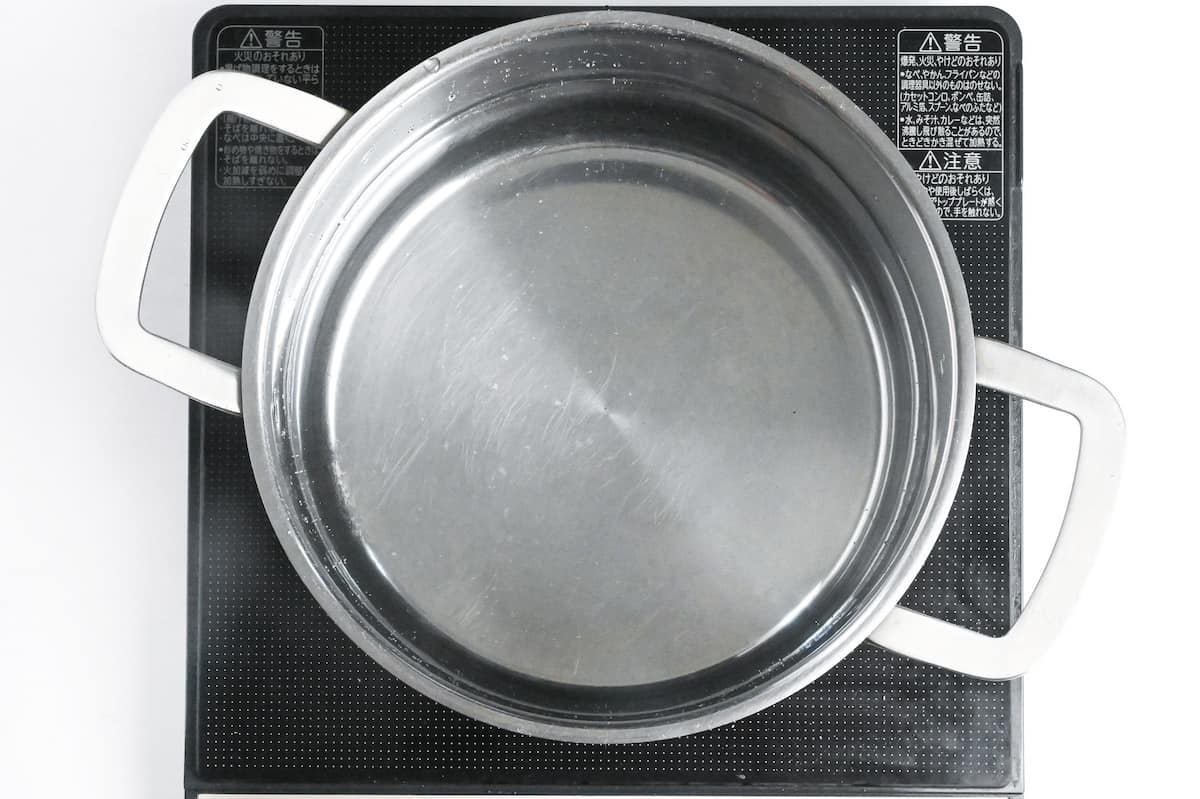
Start heating a large pot of water with enough water to submerge the pork. Once it starts to boil, lower the heat to simmer.
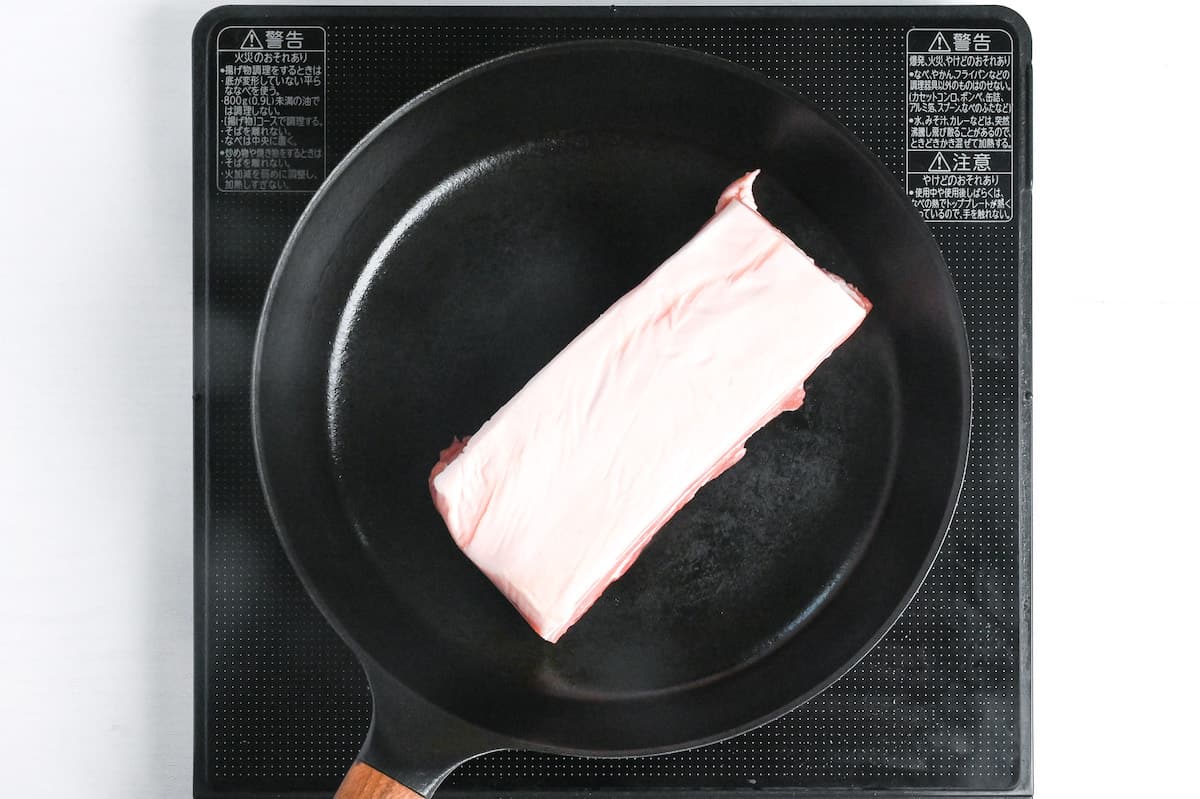
While you wait for the water, heat a frying pan on medium/medium-high and sear all sides of the pork belly.

Once seared, transfer the pork block to a chopping board and leave it to cool for a few minutes. Once cool enough to touch, cut it into chunks.
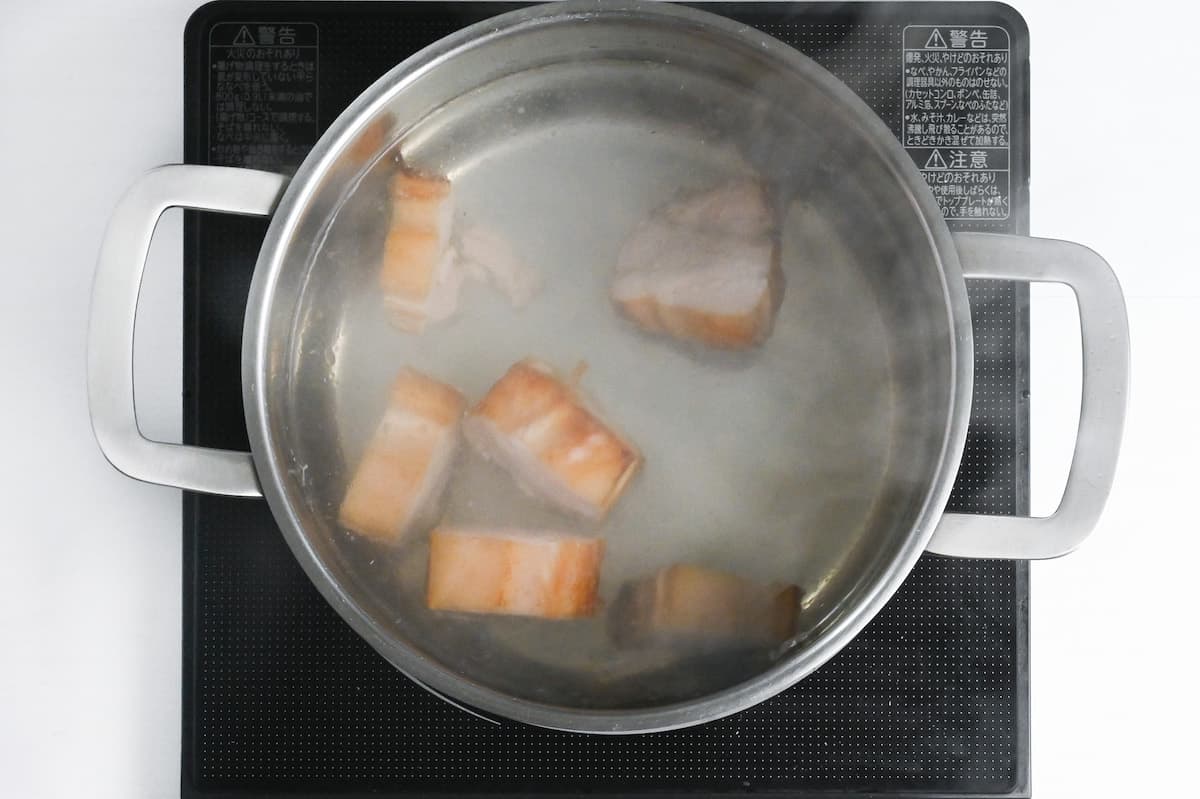
Add it to the pot of water and simmer for 10 minutes.
The purpose is to remove the excess fat to make the meat extra tender. Pork belly has a lot of fat, but the best part of kakuni is to enjoy the melted fat. By pre-boiling the meat, you can remove the excess fat and only enjoy the tasty parts.
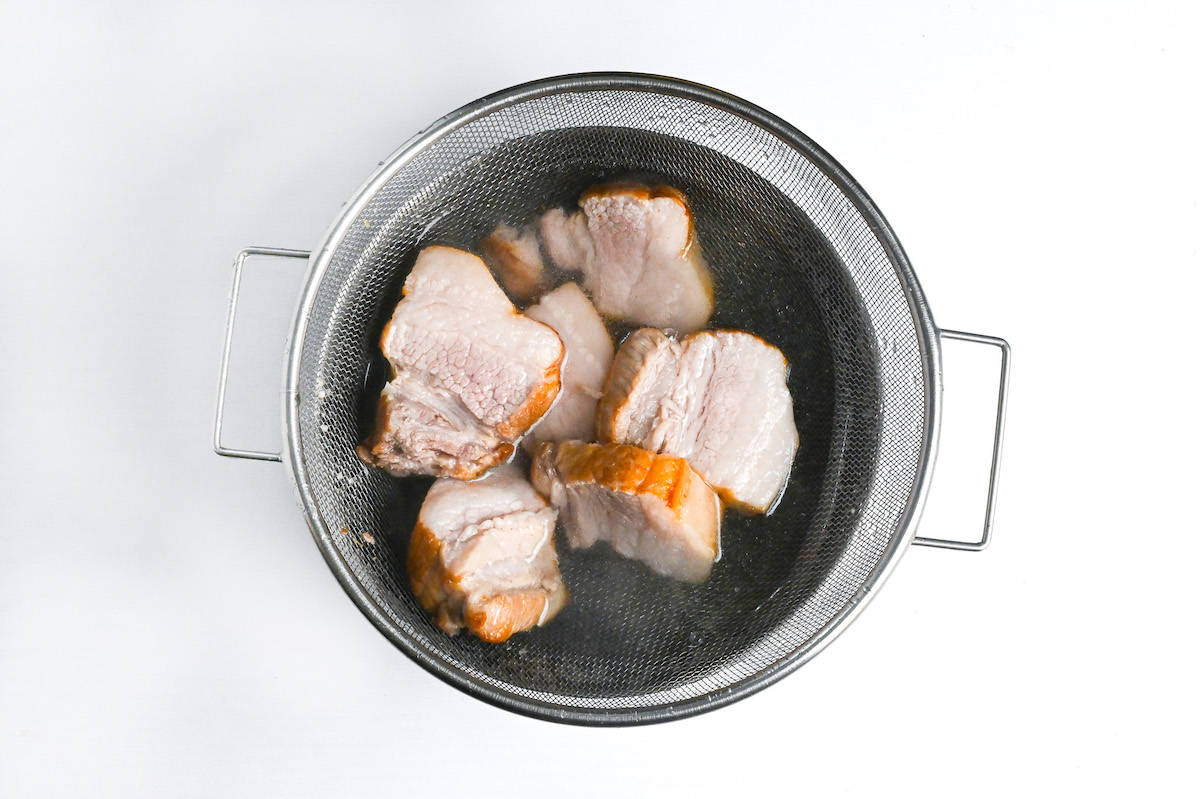
Place a sieve or colander in the sink and pour in the contents of the pot to drain the water. Rinse the pork with fresh water to clean it.

Rinse out the pot fill it with fresh water (enough to cover the pork), and bring it back to a boil. While you wait, cut a leek into thirds and slice some fresh ginger. (Save some of the white part of the leek for later.)
Once the water starts to boil, add the pork, leek, and ginger, and lower the heat to simmer. Simmer for 1 hour and top up the water if necessary to ensure the pork is always submerged. After one hour, turn off the heat.
One of the reasons the meat might become tough is because the surface of the pork dries out during the simmering process. Exposing any part of the pork to the air can cause it to harden or dry out. Ensure it’s always submerged in the liquid, and add more water if necessary.
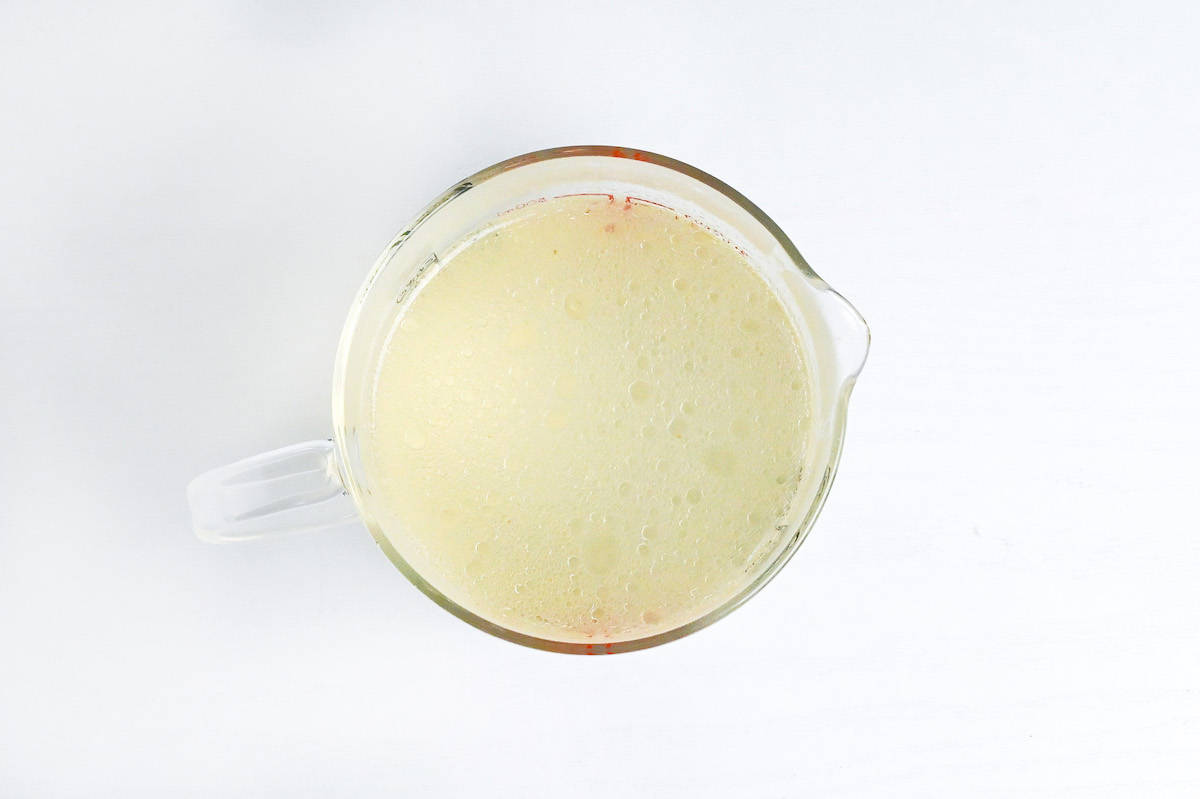
Measure out the appropriate amount of cooking liquid from the pot. This is a light pork stock that is used to add depth to the marinade.
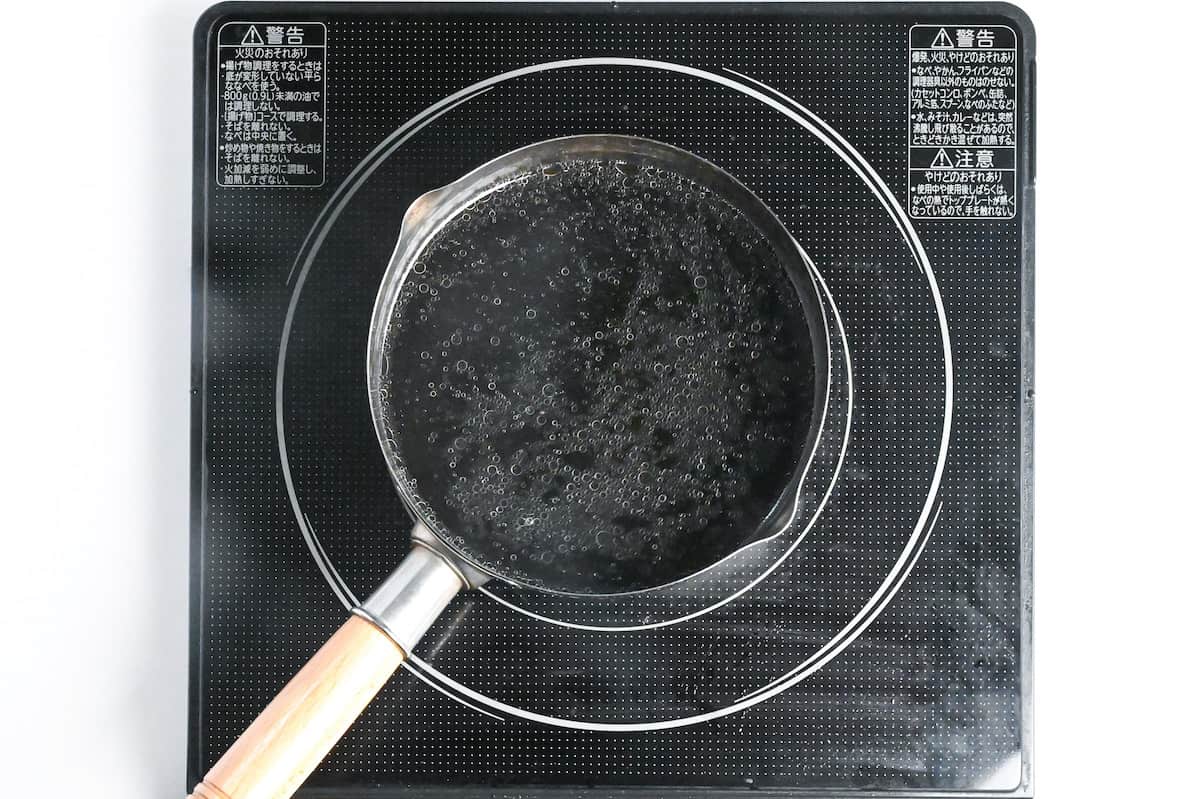
Pour it into a large saucepan and add larger beer, honey, light brown sugar, and soy sauce. Mix well and bring to a boil.
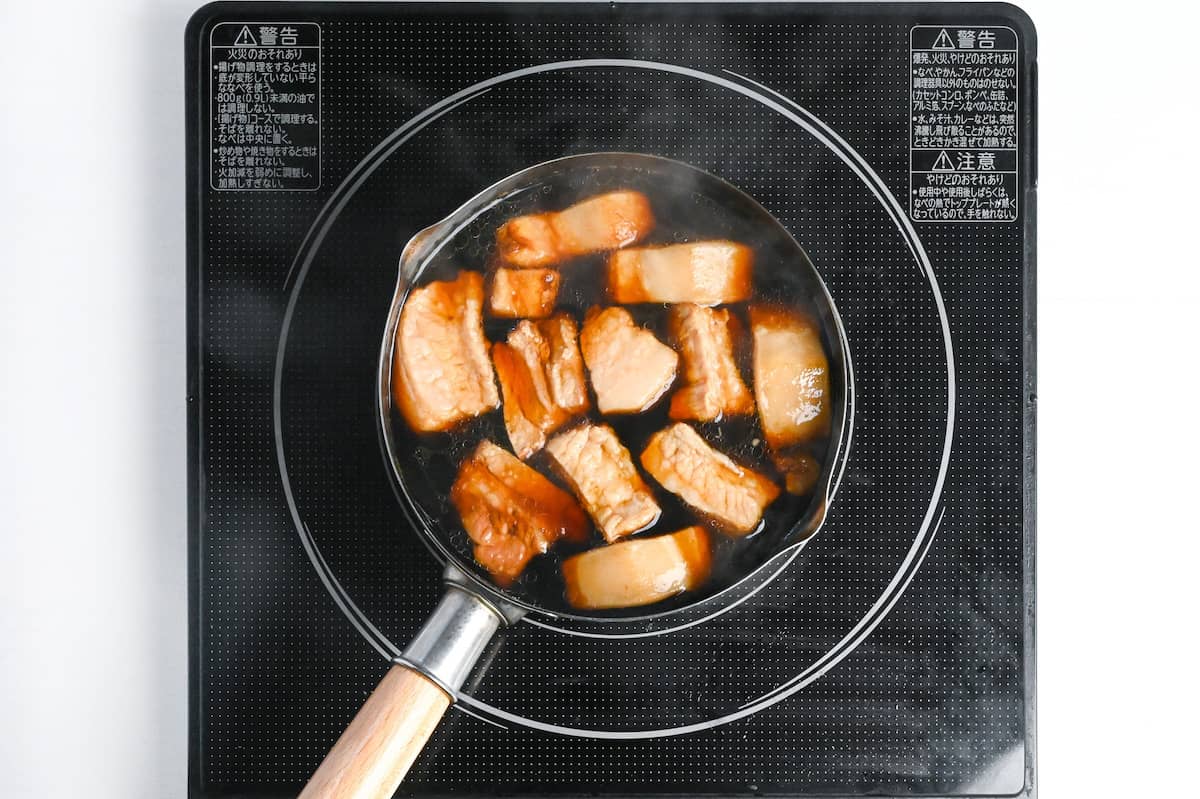
Lower to simmer and add the pork.
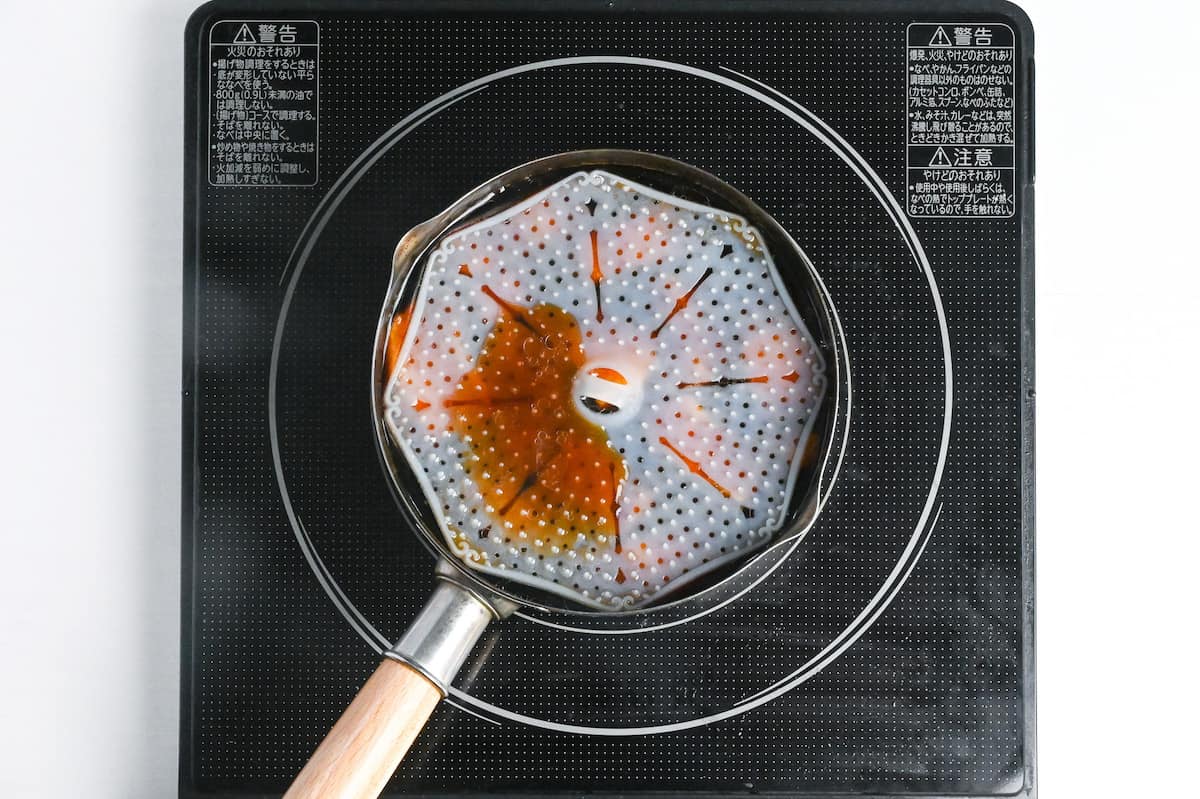
Ensure the pork is submerged in the broth by using a drop lid to weigh it down. Simmer for 30 minutes.
A drop lid (otoshibuta) is a Japanese cooking tool for simmering. They promote even cooking and flavoring and reduce the amount of evaporation. You can find drop lids made from wood, stainless steel, or silicone. Alternatively, you can make your own drop lid using baking parchment or foil. In my article, “How to make Otoshibuta, ” you can learn more about how to make drop lids.”
Turn off the heat and leave it to cool. Once cool enough to touch, you can add some boiled eggs to make marinated eggs. Marinate in the pot for 1 hour. If you plan to marinate longer, transfer it to the fridge.
Allowing the pork to cool in the broth will help the meat absorb maximum flavor. It’s also a great opportunity to make flavored eggs, so why not?
Return the pot to the stove and heat on medium for about 15 minutes or until warmed through. Remove the eggs after 5-10 minutes to stop them from overcooking.
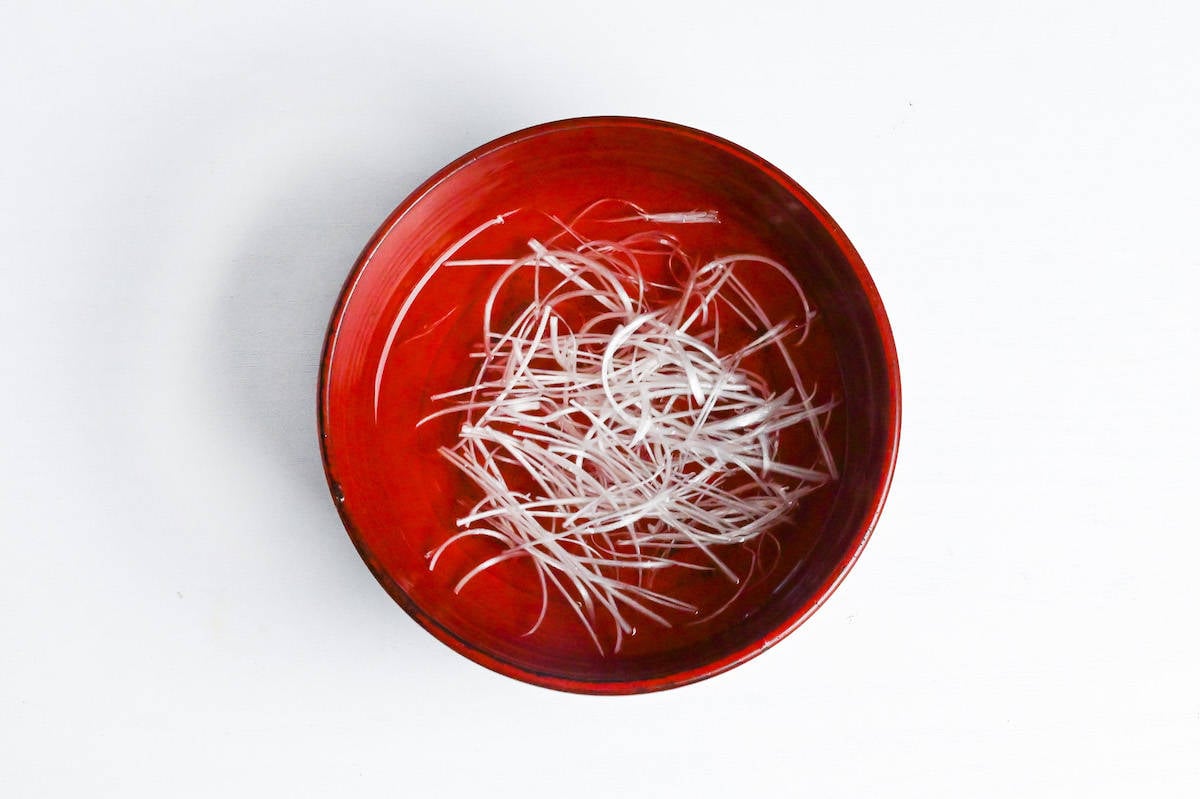
While you wait, thinly slice the white part of the leek and soak it in a bowl of lightly salted water. This style of leek garnish is called “shiraganegi” which means “white hair onions.”
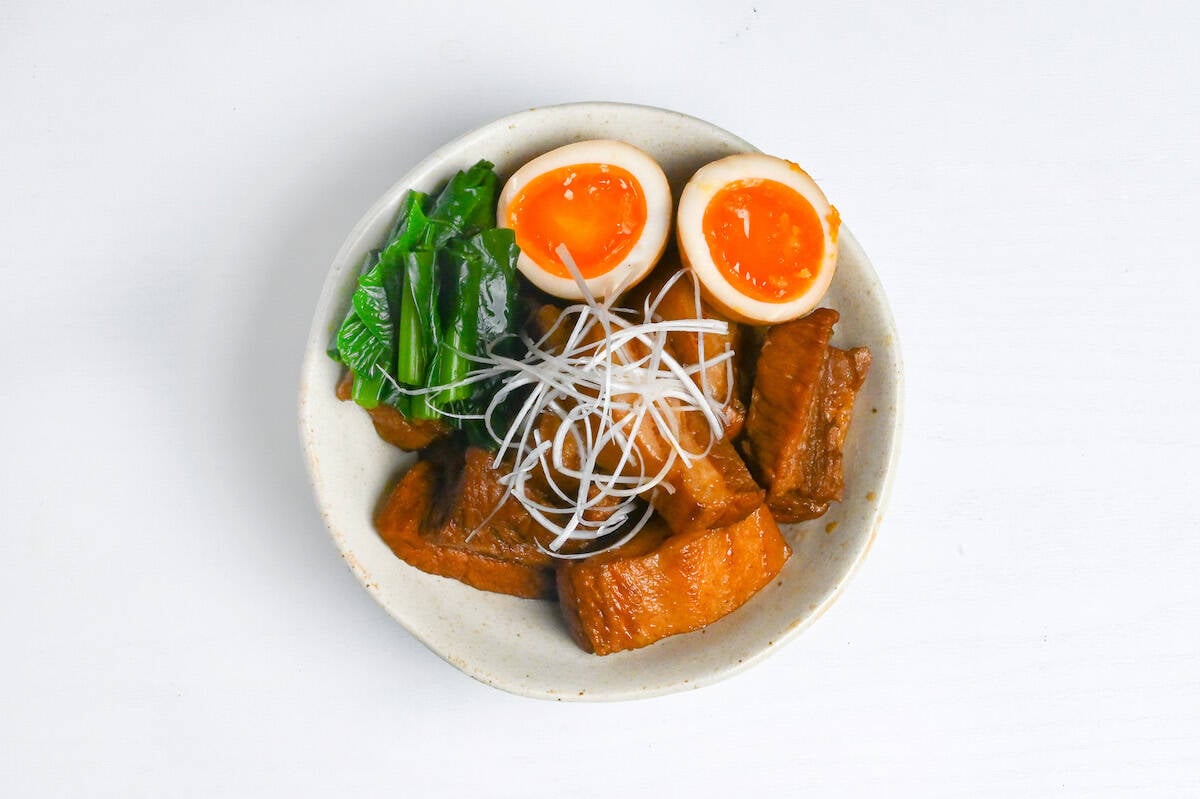
Serve buta no kakuni with marinated eggs and blanched greens, shreds of leek and a blob of Japanese mustard either as a side dish or over rice.
Enjoy!
Jump to Full Recipe MeasurementsRepurpose Leftover Kakuni Broth
The braising liquid from kakuni is a flavorful concoction, rich with the essence of the pork and the depth of soy sauce. Discarding it would indeed be wasteful. Here are some creative ways to repurpose this umami-packed liquid:
- Noodle Soups: Transform it into a base for ramen or udon by adjusting it with soy sauce, salt, pepper, or chicken stock powder. If you have any remaining kakuni, they make an excellent topping, too.
- Japanese Curry’s Secret Ingredient: Elevate Japanese-style curry with this flavorful broth. Gradually add to taste and witness the depth it brings to your curry.
- Fried Rice: Use the residual lard as your cooking oil and a dash of the marinade for seasoning to make a fantastic chahan!
- Marinated Eggs: Create ajitama eggs by reducing the marinade a little, then immerse soft-boiled eggs in it for a delightful flavor infusion.
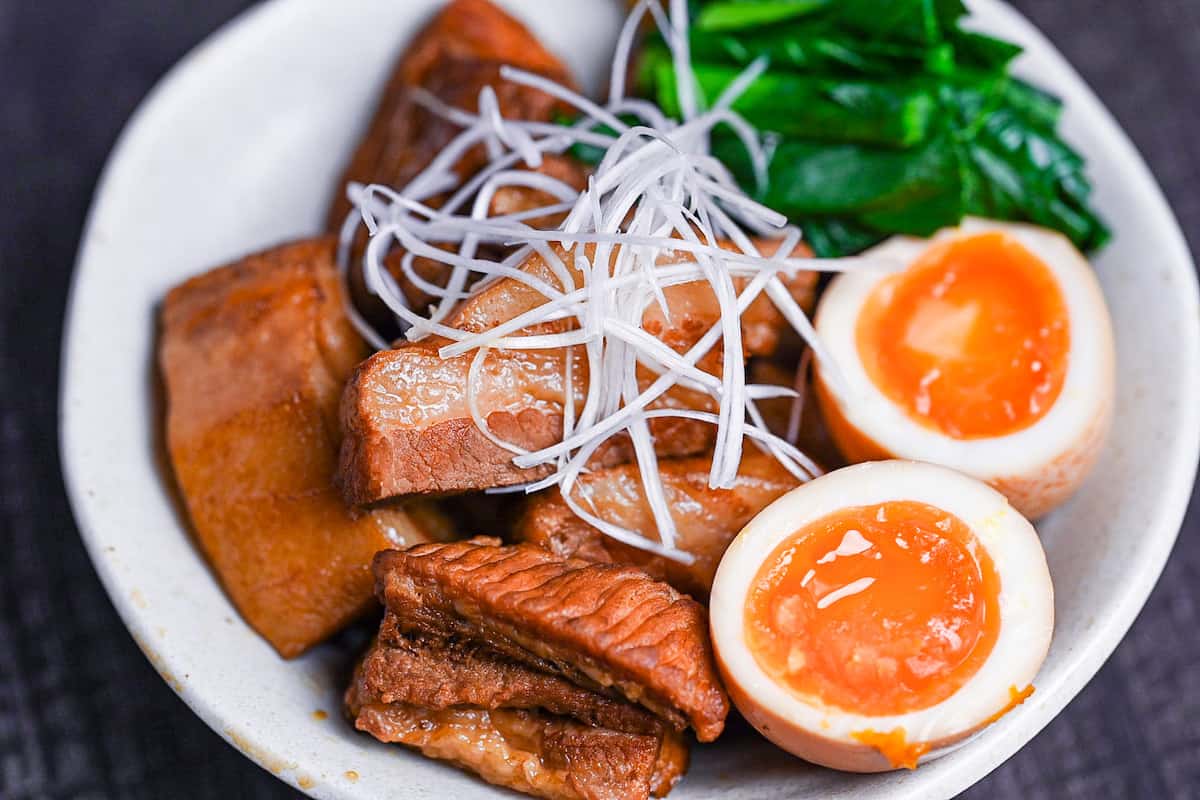
How to Store
Storing Buta no Kakuni properly ensures that you can enjoy this delicious dish even on later days. It can be kept in the refrigerator for up to 3 days and in the freezer for up to 2 weeks.
For refrigeration:
- Let the kakuni cool down completely.
- Transfer it into a container, ensuring the braising liquid covers the pork.
- Seal the container tightly to prevent air exposure and refrigerate.
For freezing:
- Let the kakuni cool down completely, then place it in a zippered freezer bag.
- Pour in the braising liquid.
- Expel as much air as possible from the bag before sealing and freeze.
Storage summary
Room temperature – Not recommended.
Refrigerated – Up to 3 days.
Frozen – Up to 2 weeks.
FAQ
Here are answers to frequently asked questions I have received across all platforms, including here, YouTube, Instagram, and Pinterest. If you have any questions, feel free to send them to me anytime! It will be a big help for everyone in this community!
For steamed buns, I’d personally reduce some of the marinade until it thickens and combining it with a blend of mayonnaise and a bit of karashi (or smooth Dijon) mustard to make “karashi mayo”. To assemble, layer shredded cabbage in the bun, top with the pork, then drizzle with both the reduced marinade and the mustard-mayo sauce! I hope this helps!
Yes, you can refrigerate the braised pork and eggs in the marinade overnight. After braising with marinade, let them cool to room temperature, then refrigerate it with a lid on. The flavors will continue to penetrate the meat and eggs overnight. Don’t worry about over-marination – overnight is perfectly fine! When you’re ready to eat, simply reheat everything together in a pot until warmed through.
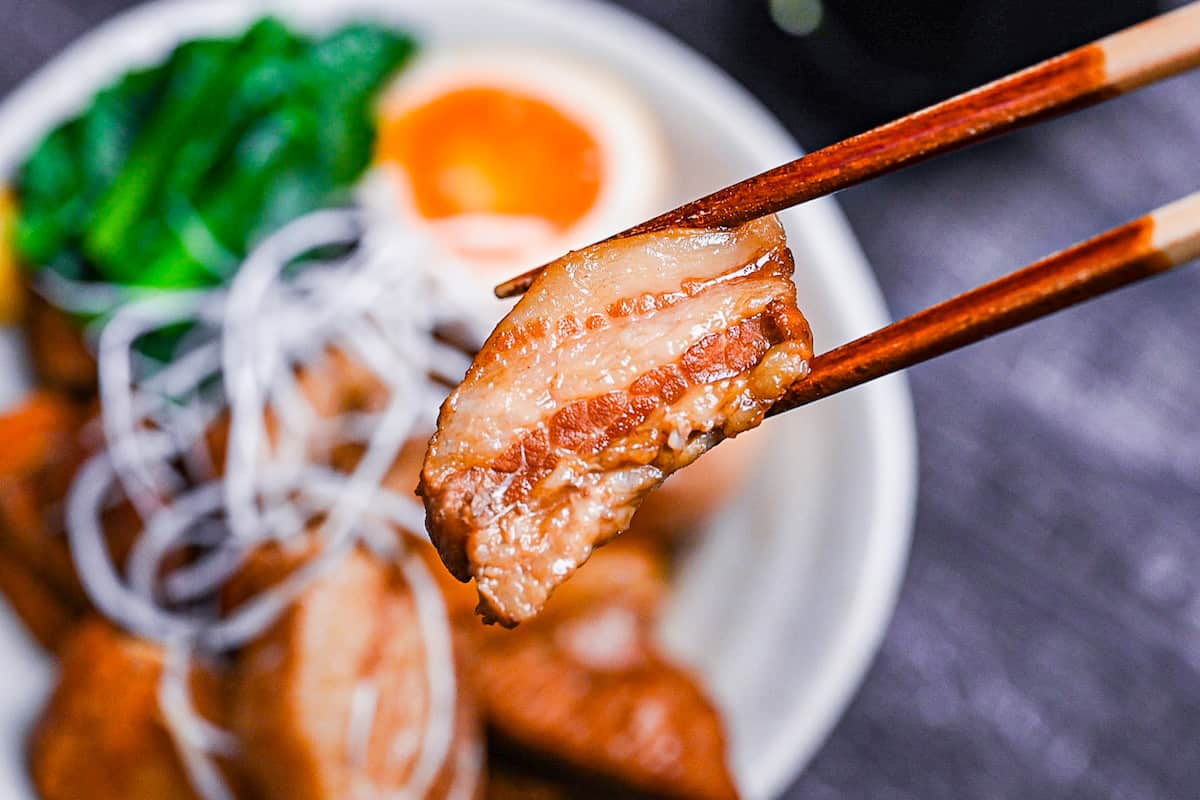
I hope you enjoy this Buta no Kakuni recipe! If you try it out, I’d really appreciate it if you could spare a moment to let me know what you thought by giving a review and star rating in the comments below. It’s also helpful to share any adjustments you made to the recipe with our other readers. Thank you!
More Similar Japanese Recipes
- Pork Chashu for Ramen
- Chashu Donburi (Braised Pork Rice Bowl)
- Chicken Chashu (Braised Chicken Thigh)
- Ajitama (Marinated Eggs/Ramen Eggs)
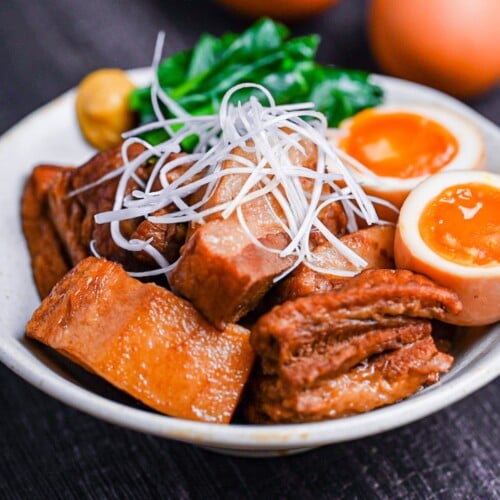
Buta no Kakuni (Japanese Braised Pork Belly)
Ingredients
- 600 g slab skinless pork belly
- 30 g ginger root
- 1 Japanese leek (naganegi) green part
Marinade
- 500 ml pork broth the liquid from cooking the pork
- 100 ml lager beer
- 1 tbsp honey
- 2 tbsp light brown sugar
- 100 ml Japanese soy sauce (koikuchi shoyu)
- 4 soft-boiled egg optional
- Japanese leek (naganegi) white part, optional garnish
- Japanese mustard (karashi) optional, or hot English mustard
My recommended brands of ingredients and seasonings can be found in my Japanese pantry guide.
Can’t find certain Japanese ingredients? See my substitution guide here.
Instructions
Part 1
- Start heating a large pot of water (enough to submerge the pork). When it reaches boiling, turn it down to a simmer.

- Heat a frying pan on medium/medium-high and sear 600 g slab skinless pork belly on all sides.

- Once seared, transfer the pork to a chopping board and let it cool for a few minutes. When it’s cool enough to touch, cut it into chunks.

- Place the chunks in the pot of water and allow to simmer for 10 minutes.

- After 10 minutes have passed, pour the pork into a colander and wash it with cold water. Rinse out the pot, fill it with enough water to cover the pork, and bring to boil once more.

- Cut 30 g ginger root into slices and break 1 Japanese leek (naganegi) into thirds. Once the water starts to boil, add them to the pot along with the pork, and lower the heat. Simmer for one hour.Make sure the pork is always submerged and top up the water if necessary.

Part 2
- After one hour, turn off the heat and measure out 500 ml pork broth from the pot with the pork.

- Pour it into a large saucepan and add 100 ml lager beer, 1 tbsp honey, 2 tbsp light brown sugar and 100 ml Japanese soy sauce (koikuchi shoyu). Mix and bring to boil.

- Once boiling, lower the heat to simmer and add the pork.

- Place a drop lid on top of the pork and simmer on low for 30 minutes.After 30 minutes, turn off the heat and leave to cool. Once cool, add 4 soft-boiled egg (optional) and marinate in the pot for 1 hour. (You can store it in the fridge if you plan to marinate longer.)

- Return the pot to the stove and heat on medium for about 15 minutes or until warmed through. Remove the eggs after 5-10 minutes to prevent overcooking.

- If you want to garnish with "shiraganegi", cut the white part of a Japanese leek (naganegi) into thin strips and soak in lightly salted water until serving.

- Dish up and serve with Japanese mustard (karashi).

- Enjoy!
Video
Notes
- This dish is quite time consuming so I recommend making a large batch so you can use it for multiple meals.
- If you increase the pork in the recipe, increase the broth in part 2 accordingly. (It needs to be submerged and you might be able to get away with using less broth depending on the size of your pan.)
- Note: The nutritional information includes the marinade.
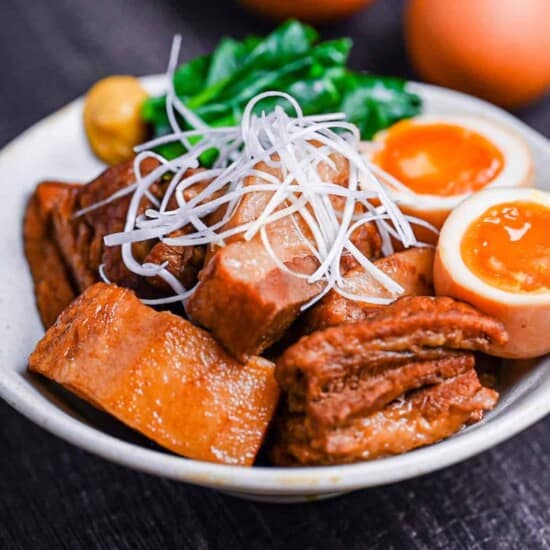




Mr Yuto!
I’ve been scouring for all the different Japanese across the internet. All your recipes are absolutely SMASH HITS.
I’ve cooked your gyudon, oyako-don, yakitori don, Japanese dry curry and today, This recipe right here.
You keep on producing hit after hit after hit of good quality recipes that are sure to tantalize the tastebuds!
Please keep up the good work!
Arigato gozaimasu!
Hi Joel,
Thank you for the comment and your kind words! It means a lot!
I’m so happy that you enjoyed every recipe so far!
I will try my best to keep adding more and more recipes, stay tuned! 🙂
Yuto